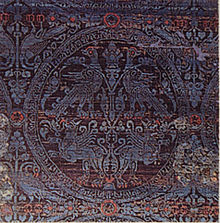

This article or section appears to contradict itself. Please see the talk page for more information. (November 2022)
|

The Silk Road
| |
| Date | Mid-6th century (552/563 CE) |
|---|---|
| Location | Central Asia |
| Participants | Two monks |
| Outcome | Establishment of Roman silk industry |
In the mid-6th century CE, two monks, with the support of the Roman emperor Justinian I, acquired and smuggled living silkworms into the Roman Empire, which led to the establishment of an indigenous Roman silk industry that long held a silk monopoly in Europe.

Silk was first produced sometime during the third millennium BCE by the Chinese. By the first century CE, there was a steady flow of silk into the Roman Empire.[1] With the rise of the Sassanid Empire and the subsequent Roman–Persian Wars, importing silk to Europe became increasingly difficult and expensive. The Persians strictly controlled trade in their territory and would suspend trade in times of war.[2] Consequently, the Roman Emperor Justinian I tried creating alternative trade routes to Sogdiana, which at the time had become a major silk-producing centre:[3] one to the north via Crimea, and one to the south via Ethiopia.[4] The failure of these efforts led Justinian I to look elsewhere since demand for this luxury good was high, even within his inner circle.[5]
Two unidentified monks (most likely members of the Nestorian Church[1][4]) who had been preaching Christianity in India (Church of the East in India), made their way to China by 551 CE.[6] While they were in China, they observed the intricate methods for raising silkworms and producing silk.[6] This was a key development, as the Romans had previously thought silk was made in India.[clarification needed][7] In 552 CE, the two monks sought out Justinian I.[4] In return for his generous but unknown promises, the monks agreed to acquire silkworms from China.[clarification needed][3] They most likely traveled a northern route along the Black Sea, taking them through the Transcaucasus and the Caspian Sea.[8]
Since adult silkworms are rather fragile and have to be constantly kept at an ideal temperature, lest they perish,[9][clarification needed] they used their contacts in Sogdiana to smuggle out silkworm eggs or very young larvae instead, which they hid within their bamboo canes.[clarification needed][8][4] Mulberry bushes, which are required for silkworms, were either given to the monks or already imported into the Roman Empire.[8] All in all, it is estimated that the entire expedition lasted two years.[10]

Shortly after the expedition there were silk factories in Constantinople, Beirut, Antioch, Tyre, and Thebes.[4] The acquired silkworms allowed the Roman Empire to have a silk monopoly in Europe. The acquisition also broke the Chinese and Persian silk monopolies.[8] The resulting monopoly was a foundation for the Roman economy for the next 650 years until its demise in 1204.[11] Silk clothes, especially those dyed in imperial purple, were almost always reserved for the elite in Byzantium, and their wearing was codified in sumptuary laws.[1] Silk production in the region around Constantinople, particularly in Thrace in northern Greece, has continued to the present (see: Silk museums of Soufli).